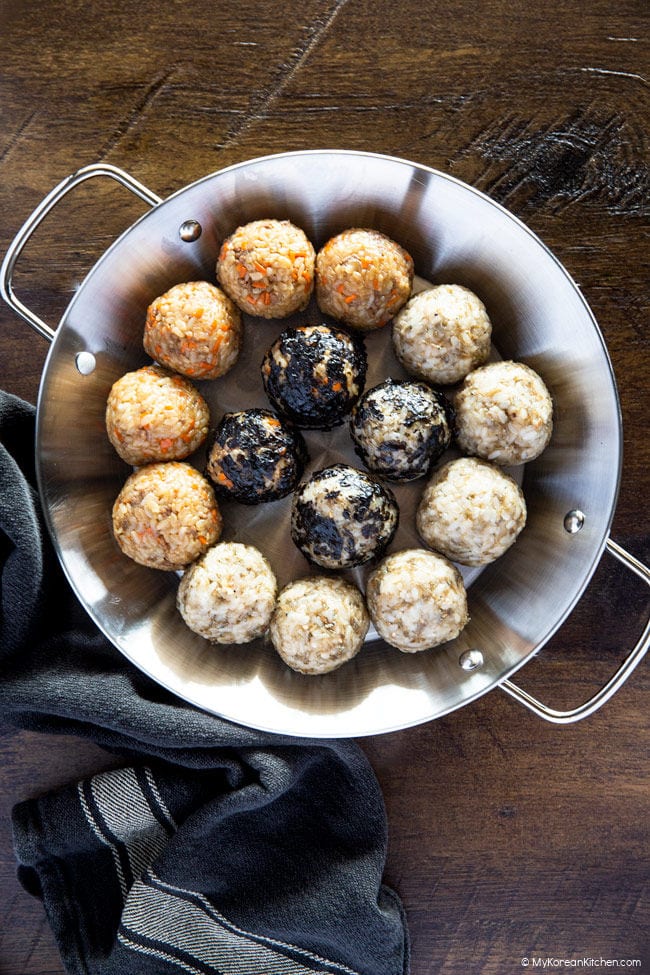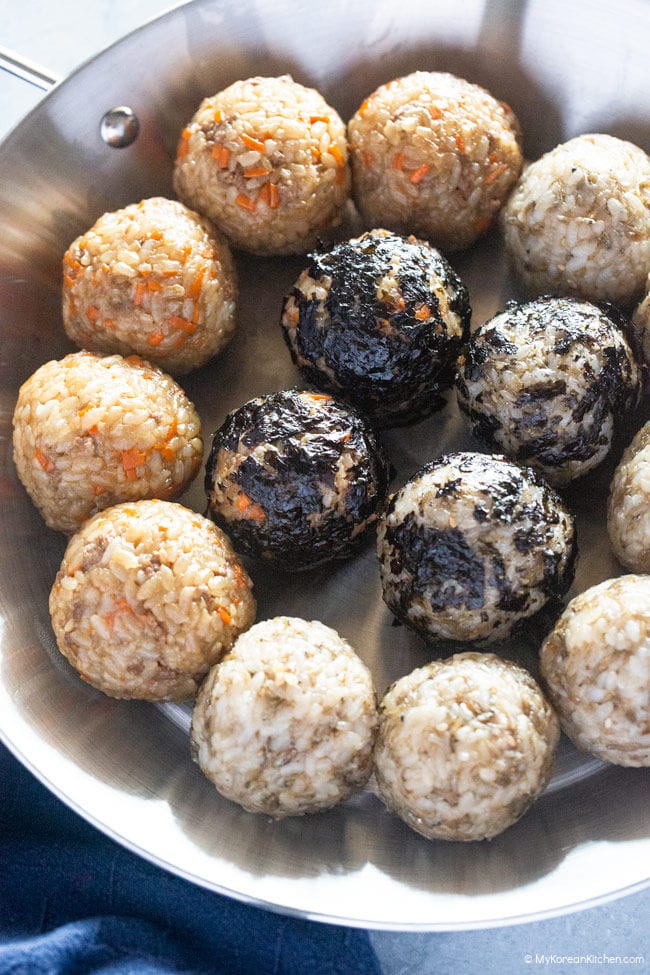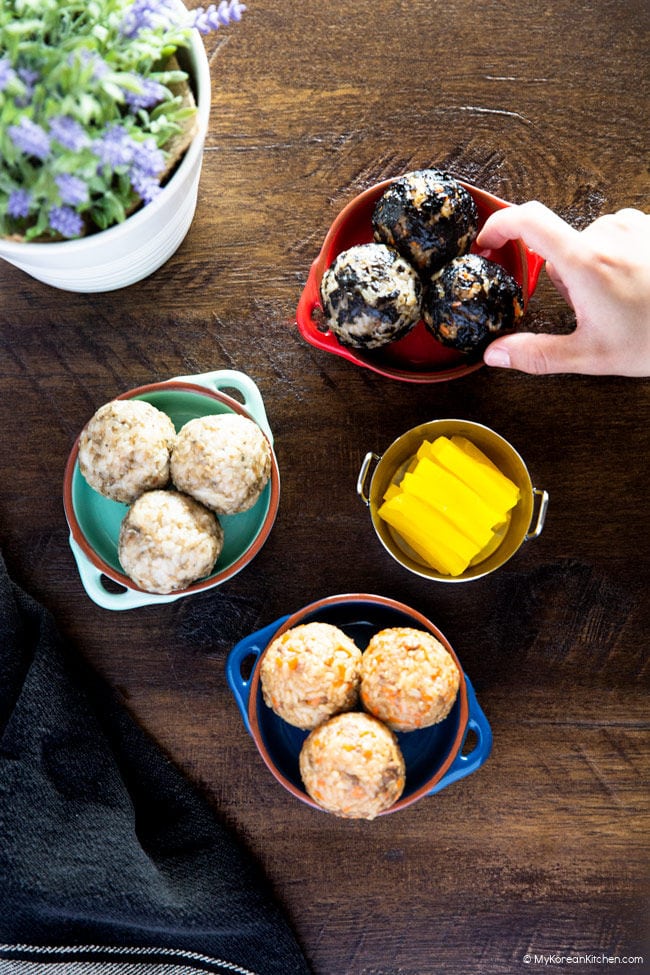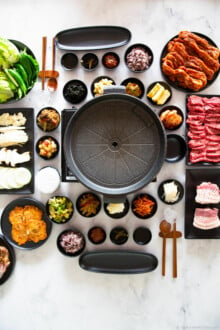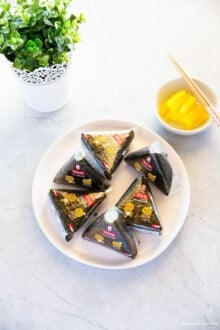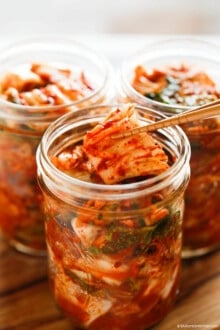Learn how to make Korean rice balls, Jumeokbap! These are sure to delight any crowd. They’re simple and fun to put together. Here I will share two popular Korean rice ball recipes.
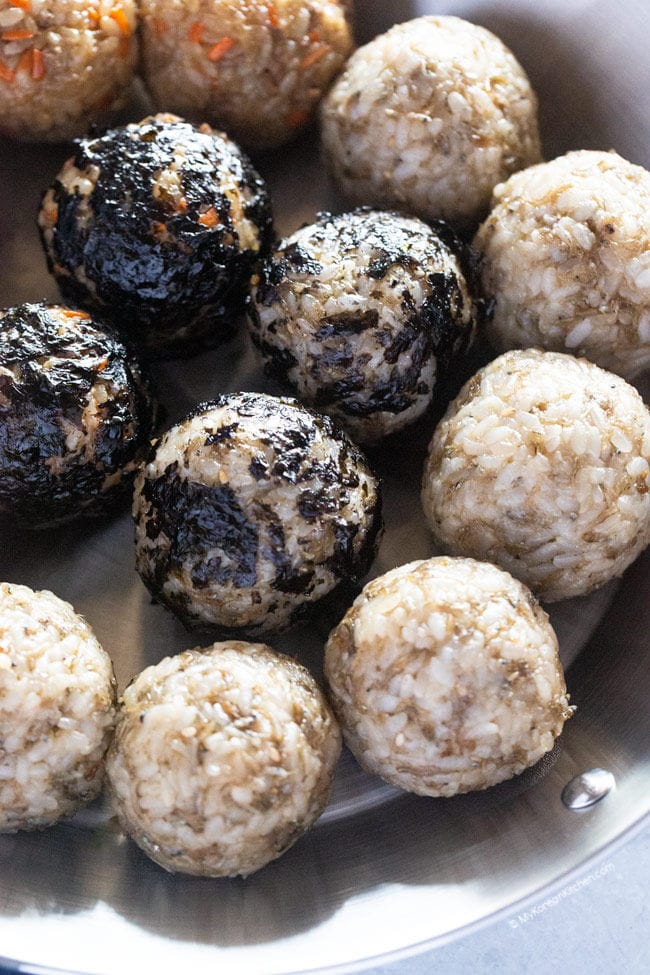
What Are Korean Rice Balls (Jumeokbap)
The Korean word for “rice ball,” Jumeok-bap (주먹밥), literally means “rice held in the fist.”
For centuries, rice balls have been used as a portable, easy-to-eat meal that can be eaten on the go. Recently, it has become a favorite food of busy people for a quick meal outside the house.
Rice balls are versatile because they can be made with a variety of fillings. Some of the most basic ones include rice, salt, sesame oil, and sesame seeds. But you can add either or both vegetables and meat into these rice balls to make them more filling and nutritious.
Korean rice balls especially go well with spicy foods (e.g. spicy Korean baby back ribs) as a rice based “side dish”. Some Korean restaurants might serve you a bowl of rice, topped with shredded dried seaweed, sesame oil, and green onions, so you can make super quick and easy DIY rice balls while the main meal (usually meat) is getting cooked on the table.
Rice balls are a popular dish in Korea and Japan, where sticky japonica rice is the staple food. This rice variety is easy to lump up as it is naturally sticky. Japanese rice balls are called Onigiri (오니기리).
On the other hand, indica rice, which is mainly used in other Asian countries, will be much harder or impossible to lump together unless it is glutinous rice.
Korean Rice Balls and Its Symbolic Meaning
Korean rice balls don’t show up often in Korean media compared to other Korean dishes (e.g. Korean fried chicken, instant noodles, or tteokbokki). But sometimes they do, and it’s usually to express the misfortunes of war or the struggles of a lower-class person in the historical drama.
In modern times, rice balls are often popular as a picnic food. Also, mothers with picky eaters often make rice balls. Kids seem to accept them better than when the rice is served plainly.
They’re also popular for people who are in a hurry and short on time, as they can quickly buy them from a convenience store and go about their business. They’re usually sold as triangle kimbap (samgak kimbap).
My Best Cooking Tips
- To make rice balls that will actually stay together, use short- or medium-grain rice (e.g. japonica rice, such as sushi rice). Long-grain rice won’t stick well unless it’s glutinous rice (also known as sweet rice or sticky rice).
- If you cook 3 cups of raw rice using the rice measuring cup (1 cup = 180 ml), it will result in about 6 cups of cooked rice. (The later is measured using a regular measuring cup, 1 cup = 250 ml). For those who prefer to measure rice by weight, 1 rice measuring cup of raw rice equates to about 165 g / 5.8 ounces.
- The recipe below contains two different Korean rice ball dishes. If you’re pressed for time, or prefer one flavor over the other, feel free to make only one of these recipes.
- You can buy pre-packaged seasoned seaweed flakes from a Korean grocer. Or, you can easily make it by putting seasoned seaweed into a small food grade plastic bag and crushing it finely using your hands.
How to Serve Korean Rice Balls
Jumeokbap is made for convenience and easy of eating, meaning you don’t need to serve it with anything else. That being said, these go well with (yellow) pickled radishes, pickled cucumber, kimchi and also warm broth based soup (e.g. doenjang guk with much less toppings)
How to Store Rice Balls
Any leftover rice balls should be kept refrigerated in an airtight container for 2 to 3 days. You can also freeze them for about a month. If you do freeze, wrap individual rice balls in cling wrap and put them in a zip lock bag. These can be reheated in a microwave.
More Korean Rice Recipes
If you love rice dishes, you should check my below recipes for more creative ideas. They are simply delicious and a crowd pleaser!
Ingredients for Jumeokbap, Makes 14 to 16 Rice Balls
Korean Beef Rice Balls
Main
- 150 g / 5.3 ounces minced beef
- 70 g / 2.5 ounces carrots, finely chopped
- 3 cups (520 g / 18.3 ounces) cooked rice, short or medium grain rice (e.g. sushi rice)
Sauce
- 3 Tbsp soy sauce, regular
- 1 Tbsp rice wine (mirin)
- 1.5 Tbsp dark brown sugar
- 1 tsp sesame oil
Seasoned Anchovy Rice Balls
Main
- 80 g / 2.8 ounces dried anchovies, extra small, cut into fine pieces
- 3 cups (520 g / 18.3 ounces) cooked rice, short or medium grain rice (e.g. sushi rice)
Sauce
- 1 Tbsp & 1 tsp soy sauce, regular
- 1 Tbsp & 1 tsp rice wine (mirin)
- 1 Tbsp dark brown sugar
- 1/2 Tbsp honey
- 1/2 Tbsp sesame oil
- 1 tsp sesame seeds
Optional
- 1/2 cup seasoned seaweed flakes
*1 Tbsp = 15 ml, 1 cup = 250 ml
How to Make Korean Rice Balls (Jumeokbap)
Korean Beef Rice Balls
1. Combine the rice ball sauce in a small bowl, mix well, and set it aside.
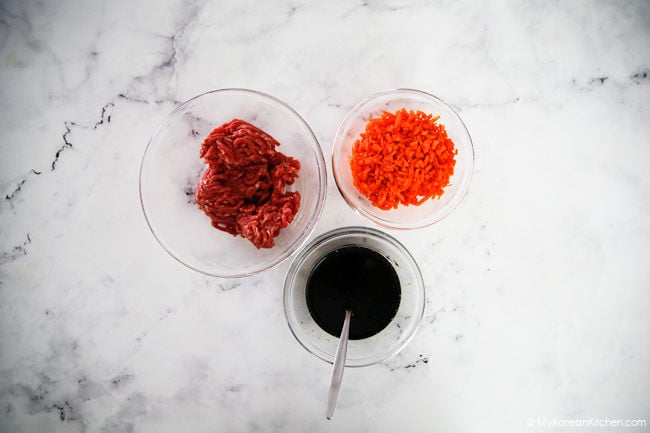
2. Preheat a pan on medium-high heat until the bottom of it is well heated. Add the minced beef and cook it until half of it is fully cooked.
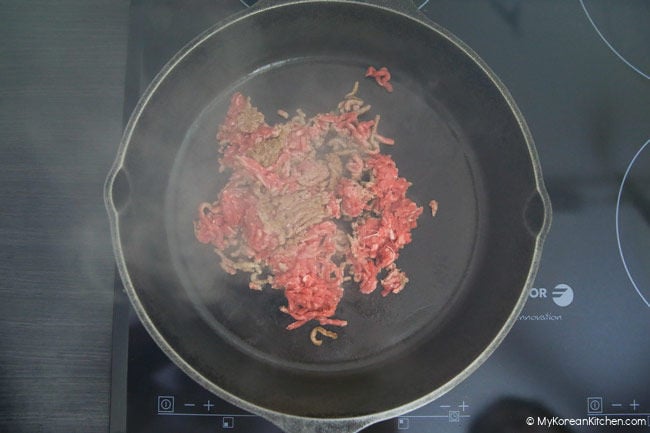
3. Add the carrots to the pan and stir. Once the beef is fully cooked, add the sauce and the rice. Mix them well. Cook until the rice is well coated with the sauce. (It takes 2-3 minutes.) Set aside the stir fried beef and rice in a medium-sized bowl and cool down until safe to touch.
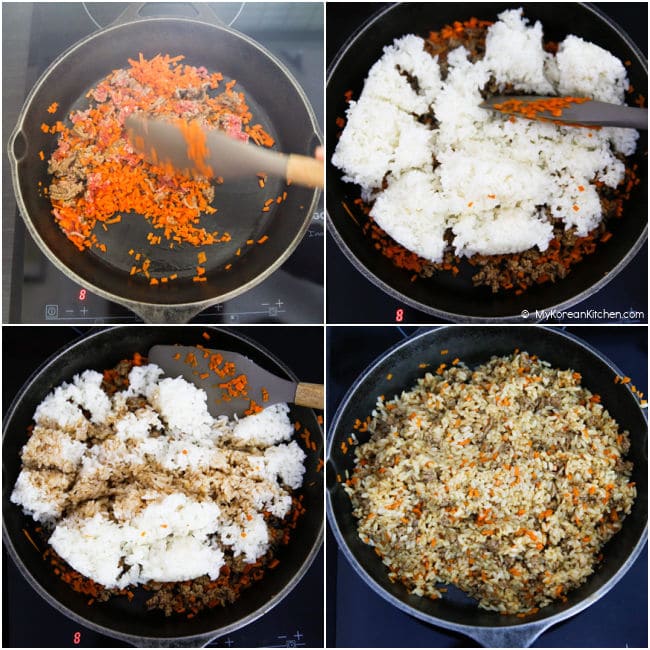
4. Squeeze one fistful of stir fried beef and rice mixture between your two hands until the rice sticks together. Shape it into a ball once it is glued together. Set each aside as you make the rice balls. Repeat the step until all of the mixture is formed into balls. The number of rice balls will vary, but you can get between 7 to 8 rice balls for a small fistful size.
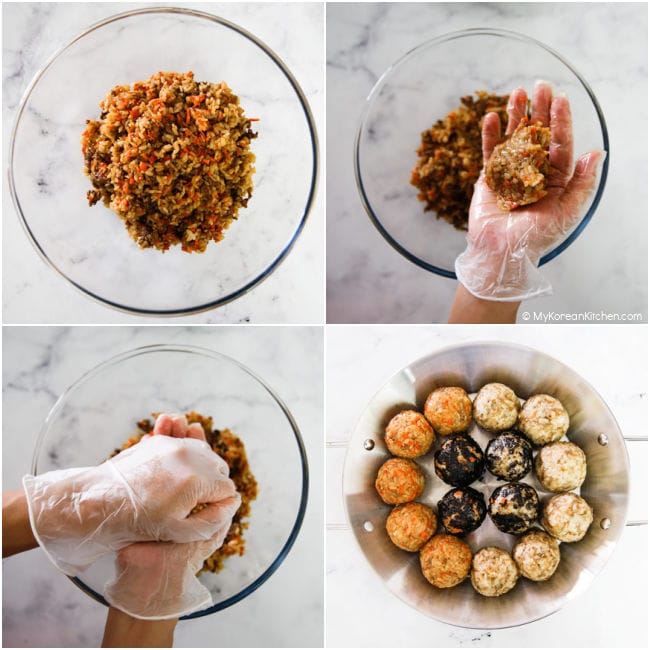
5. (Optional) Coat the rice balls with seasoned seaweed flakes. You can do this by rolling them on the bed of seaweed flakes on a plate. Serve warm.
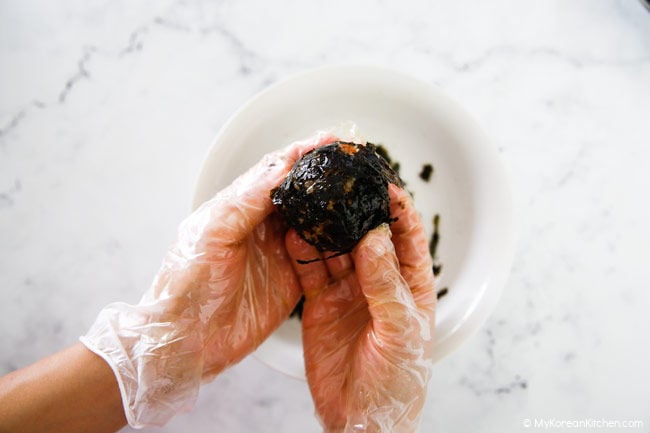
Seasoned Anchovy Rice Balls
1. Combine the rice ball sauce in a small bowl, mix well, and set it aside.
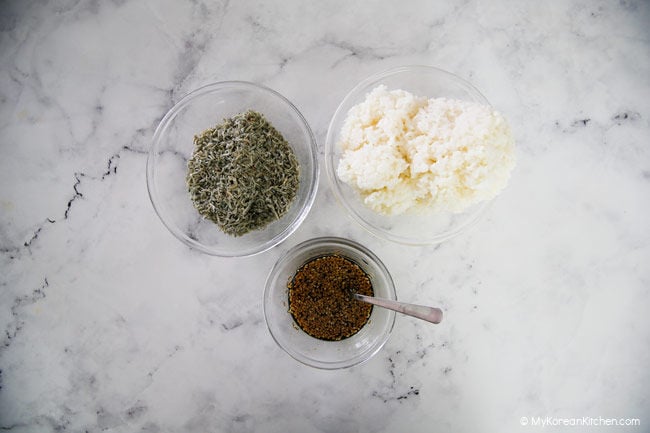
2. Preheat the pan on medium-high heat until the bottom of it is well heated. Stir fry the anchovies on medium-high heat for 1 minute to reduce the fishy smell while stirring occasionally. (Oil is not required.) Add the sauce for anchovy rice balls and mix them well. Cook until the anchovies are well coated with the sauce (about 1 minute).
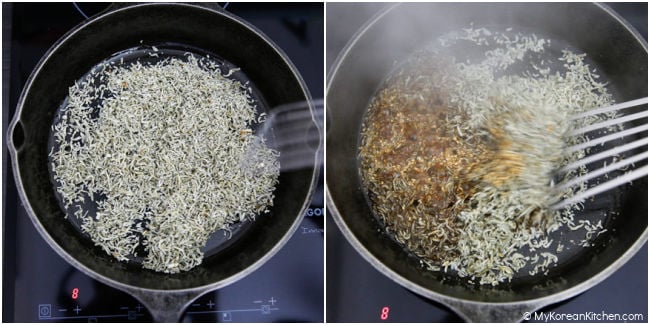
3. Prepare a medium-sized bowl and add the cooked rice (3 cups) and stir-fried anchovies. Mix them well.
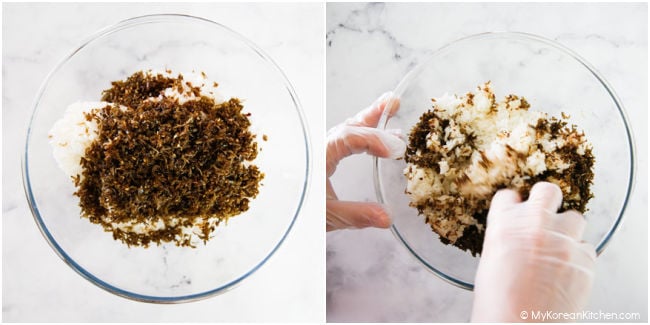
4. Squeeze one fistful of seasoned anchovy and rice mixture between your two hands until the rice sticks together. Shape it into a ball once it is glued together. Set each aside as you make rice balls. Repeat the step until all of the mixture is formed into balls. The number of rice balls will vary, but you can get between 7 to 8 rice balls for a small fistful size.
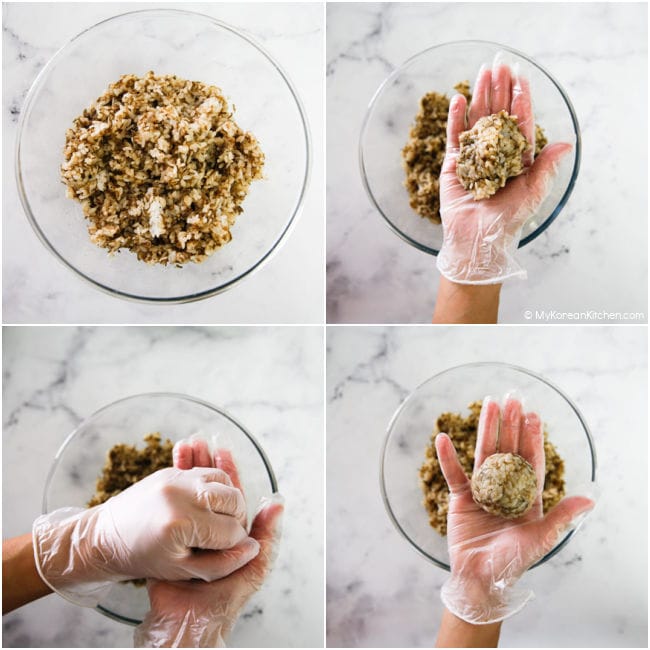
5. (Optional) Coat the rice balls with seasoned seaweed flakes. You can do this by rolling them on the bed of seaweed flakes on a plate. Serve warm.
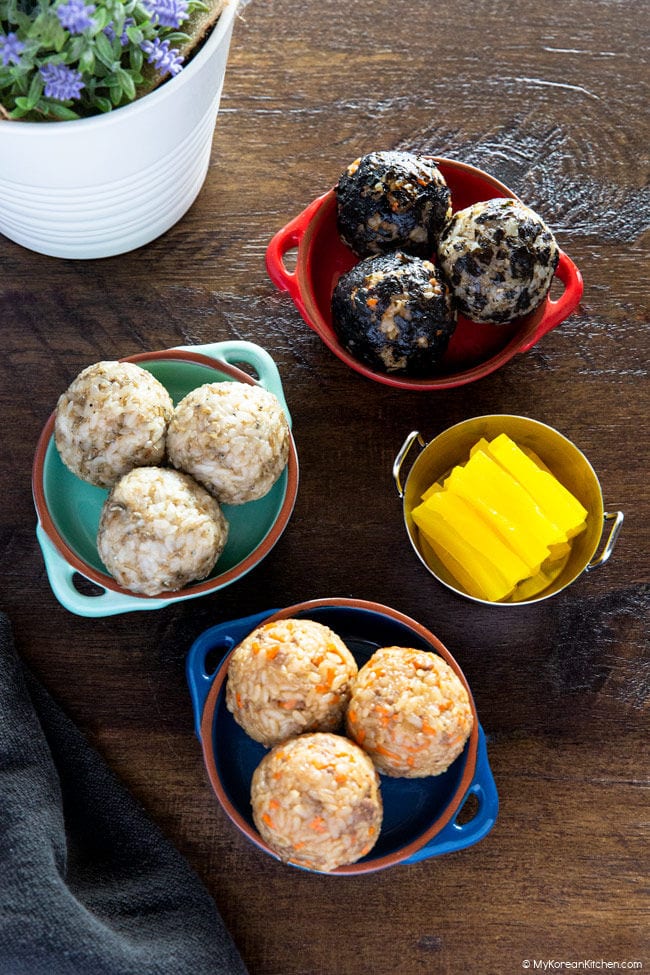
Love Korean food? Browse lots more Korean recipes from my easy Korean recipe collections. And subscribe to my newsletter for all of the latest updates including new recipes, what MKK communities are cooking and K-Dramas!
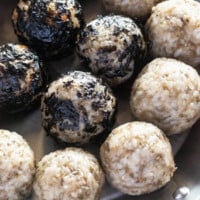
Korean Rice Balls (Jumeokbap)
Ingredients
KOREAN BEEF RICE BALLS
Main
- 150 g minced beef (5.3 ounces)
- 70 g carrots (2.5 ounces)
- 3 cups cooked rice (520 g / 18.3 ounces) cooked rice, short or medium grain rice (e.g. sushi rice)
Sauce
- 3 Tbsp soy sauce
- 1 Tbsp rice wine (mirin)
- 1.5 Tbsp dark brown sugar
- 1 tsp sesame oil
SEASONED ANCHOVY RICE BALLS
Main
- 80 g dried anchovies (2.8 ounces), extra small, cut into fine pieces
- 3 cups cooked rice (520 g / 18.3 ounces) cooked rice, short or medium grain rice (e.g. sushi rice)
Sauce
- 1.3333 Tbsp soy sauce , regular
- 1.3333 Tbsp rice wine (mirin)
- 1 Tbsp dark brown sugar
- 1/2 Tbsp honey
- 1/2 Tbsp sesame oil
- 1 tsp sesame seeds
OPTIONAL
- 1/2 cup seasoned seaweed flakes
Instructions
KOREAN BEEF RICE BALLS
- Combine the rice ball sauce in a small bowl, mix well, and set it aside.
- Preheat a pan on medium-high heat until the bottom of it is well heated. Add the minced beef and cook it until half of it is fully cooked.
- Add the carrots to the pan and stir. Once the beef is fully cooked, add the sauce and the rice. Mix them well. Cook until the rice is well coated with the sauce. (It takes 2-3 minutes.) Set aside the stir fried beef and rice in a medium-sized bowl and cool down until safe to touch.
- Squeeze one fistful of stir fried beef and rice mixture between your two hands until the rice sticks together. Shape it into a ball once it is glued together. Set each aside as you make the rice balls. Repeat the step until all of the mixture is formed into balls. The number of rice balls will vary, but you can get between 7 to 8 rice balls for a small fistful size.
- (Optional) Coat the rice balls with seasoned seaweed flakes. You can do this by rolling them on the bed of seaweed flakes on a plate. Serve warm.
SEASONED ANCHOVY RICE BALLS
- Combine the rice ball sauce in a small bowl, mix well, and set it aside.
- Preheat the pan on medium-high heat until the bottom of it is well heated. Stir fry the anchovies on medium-high heat for 1 minute to reduce the fishy smell while stirring occasionally. (Oil is not required.) Add the sauce for anchovy rice balls and mix them well. Cook until the anchovies are well coated with the sauce (about 1 minute).
- Prepare a medium-sized bowl and add the cooked rice (3 cups) and stir-fried anchovies. Mix them well.
- Squeeze one fistful of seasoned anchovy and rice mixture between your two hands until the rice sticks together. Shape it into a ball once it is glued together. Set each aside as you make rice balls. Repeat the step until all of the mixture is formed into balls. The number of rice balls will vary, but you can get between 7 to 8 rice balls for a small fistful size.
- (Optional) Coat the rice balls with seasoned seaweed flakes. You can do this by rolling them on the bed of seaweed flakes on a plate. Serve warm.
Notes
- To make rice balls that will actually stay together, use short- or medium-grain rice (e.g. japonica rice, such as sushi rice). Long-grain rice won't stick well unless it's glutinous rice (also known as sweet rice or sticky rice).
- If you cook 3 cups of raw rice using the rice measuring cup (1 cup = 180 ml), it will result in about 6 cups of cooked rice. (The later is measured using a regular measuring cup, 1 cup = 250 ml). For those who prefer to measure rice by weight, 1 rice measuring cup of raw rice equates to about 165 g / 5.8 ounces.
- You can buy pre-packaged seasoned seaweed flakes from a Korean grocer. Or, you can easily make it by putting seasoned seaweed into a small food grade plastic bag and crushing it finely using your hands.
Nutrition Info (per serving)
The nutrition information shown is an estimate provided by an online nutrition calculator. It should not be considered a substitute for a professional nutritionist’s advice.

